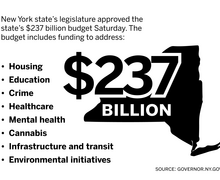Directing traffic: I-81 discussion moves to next phase as public comment period ends
Luke Rafferty I Staff Photographer
Interstate 81 will reach the end of its useful life in 2017. The Syracuse community is currently debating the future of the aging highway, which has had a controversial presence in the city since it was built in the 1950s.
With a projected timeline of about eight years, the process of deciding the future of Interstate 81 is a marathon. But the last four months have certainly felt like a sprint.
In May, the New York State Department of Transportation presented 16 different options to replace the aging highway. The options were variations on four main themes: a boulevard, a tunnel, a depressed highway or a rebuilt highway.
In June, NYSDOT released a draft scoping report, which recommended six options with a focus on either rebuilding I-81 or replacing it with a street-level highway. The public was given a chance to comment on these options starting on June 26. That public comment period ended Tuesday.
I-81 will reach the end of its useful life in 2017 and by then construction is slated to start on a new version of the highway, which has had a controversial presence in the city since it was built in the 1950s. As discussions move into the next phase, many are confused about the future direction of I-81 and who will be deciding the highway’s fate. Many Syracuse community members say the public comment period has resulted in a lot of ideas but little consensus on the best option or even what factors should be taken into account when making the decision.
“The process whereby this decision is going to be made is purposefully unclear and that’s so everyone can deny responsibility at the end,” said David Rubin, professor and dean emeritus at the S.I. Newhouse School of Public Communications. Rubin lives in the area and has been an active participantin the debate.
But when all the reports and public comments are completed, it’s not clear who will actually be making the final decision about the highway, Rubin said.
No one is sure whether the governor or the state DOT or the secretary of transportation or someone else will be making the final call, he said.
The lack of clarity over who’s in charge also makes it hard to figure out who to lobby and who is being lobbied behind the scenes, he said. Destiny USA, a strong opponent of bringing down the highway, has been lobbying various state assembly members but no one is sure how much power they will have in the process, Rubin added.
But other Syracuse institutions — including Syracuse University — have purposefully kept quiet about what option they prefer. Although SU has not backed any options, it has considered how construction on I-81 could affect the university.
In July, the I-81 workgroup appointed by Chancellor Kent Syverud released its final report, which outlined the need to improve both vehicular and pedestrian traffic on campus and on the Hill, regardless of which option is eventually chosen.
Whatever decision is made will have a huge effect on Syracuse for a long time and indicate how the city will develop going forward, Rubin said.
“This will be a sign of whether Syracuse is going to continue to be dominated by conservative, backward thinking,” Rubin said, “or whether Syracuse is finally going to decide, based on its sad history, that there are better ways to do things and that this is one good chance to try and change the character of the city.”
With the comment period now at an end, NYSDOT is now working on creating a final scoping report, said Gene Cilento, the public information officer for the Department of Transportation Syracuse region. The final report will have six or more options based on public comments. Some of the options in this report may be new or may have been ruled out earlier in the process, he said.
After the final report is completed and approved, the next step is to put together preliminary designs and prepare a draft environmental impact statement, Cilento said.
Peter Sarvers said the debate about I-81 has focused too much on the structure of the new highway and not enough on how it will affect the community.
“One of the problems has been that the media has followed the lead of the department of transportation and has been defining things in terms of what kind of roadway we want,” he said.
Sarvers is a board officer of the Alliance of Communities Transforming Syracuse, a coalition of about 30 churches and other non-profits from both Syracuse and the surrounding suburbs. In January, ACTS started the Moving People Coalition with the goal of increasing dialogue and giving people a better opportunity to share their views on the future of I-81.
There has been little discussion of how any changes to I-81 will affect the community in terms of factors such as economic development and housing, Sarvers said. For example, when I-81 was first routed through Syracuse in the 1950s, the 15th ward was bulldozed to make room for the highway, he said.
Although most people in the coalition lean toward creating a street-level highway, Sarvers said the group doesn’t have an official position yet, though he hopes to solidify one in the coming weeks.
Onondaga County Legislator Kathleen Rapp, R-5th District, said she “isn’t crazy” about any of the options that have been presented so far but said that whatever option is chosen, it’s important to keep I-81 in Syracuse. The highway makes Syracuse stand out from other cities and has played a crucial role in making Syracuse easy to travel to and from, she said.
“I was pretty disappointed,” Rapp said. “In four years of research and public meetings we’ve come up with nothing but the same.”
This viewpoint is shared by the Save81 coalition, of which Rapp is a member. The coalition consists of business owners, government officials, union members and residents who all believe in keeping I-81 in Syracuse.
Said Rapp: “Taking the spine out of Syracuse would be the wrong thing to do.”
Published on September 3, 2014 at 12:01 am
Contact Jessica: [email protected] | @JessicaIannetta




